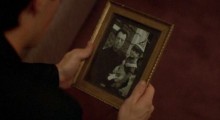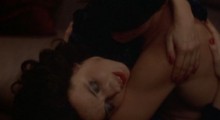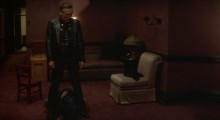Columns
-
The Blue Velvet Project, #66

Second #3102, 51:42 The frame within the frame. Jeffrey, on his way out of Dorothy’s apartment, stops and retrieves from beneath the couch the framed black and white photo of Don and Donny that Dorothy had gazed at immediately after Frank’s call. A fury of angles and lines, rectangles within rectangles. The frozen image captures a moment in time, while what transpires on the screen (no matter how many years have passed since Blue Velvet was filmed) happens right now. Seymour Chatman, in Story and Discourse, writes about still time and moving time on the screen: The effect of pure […]
-
The Blue Velvet Project, #65

Second #3055, 50:55 “I’m leaving now,” says Jeffrey. Dorothy, her back to the camera, stands in the bathroom, facing the mirror, her red shoes on the tiled floor beside her. Another radiator, like an iron spy from another world. The screen, divided against itself. Crowded by darkness, Dorothy’s space is a like a music track awaiting the vocals. The open toilet some sort of joke. A zombie film: Dorothy dead and not knowing she is dead, hungry for Jeffrey’s flesh, or the way hallways always lead to bad ends. In a room across the city, her son held hostage. The […]
-
The Blue Velvet Project, #64

Second #3008, 50:08 Dorothy’s face fills the screen, leaving no room for thought. At this moment, there is no possibility of anything outside the frame. This may seem an odd moment, an odd frame, to re-introduce the power of ideology, for there seems to be nothing overtly “political” about this frame. And yet, Dorothy’s suffering here—rendered in a fashion-photography aesthetic—is utterly reactionary and in tune with a certain mid-1980s, Ronald Reagan wave of nostalgia. In their toxic, neural pathway altering chapter from Dialectic of Enlightenment (1944) entitled “The Culture Industry: Enlightenment as Mass Deception” (an essay which remains the ultimate […]
-
The Blue Velvet Project, #63

Second #2961, 49:21 “Do you like me?” Dorothy asks. “Yes,” says Jeffrey. “Do you like the way I feel?” These are simple, almost childlike questions and answers, tender, quiet exchanges of whispered words as if to replace the previous horrors with a new hope. In John Banville’s 1997 novel The Untouchable, Victor Maskell narrates the story of his transformation into and life as a double agent for the Soviet Union during the 1930s, 40s, and 50s in England: We were latter-day Gnostics, keepers of a secret knowledge, for whom the world of appearances was only a gross manifestation of an […]
-
Codependent Lesbian Alien Seeks Same — A Hammer to Nail Review

(Codependent Lesbian Space Alien Seeks Same world-premiered in the “Park City At Midnight” section at the 2011 Sundance Film Festival. It opens for a one-week theatrical run at the reRun Gastropub in New York City on Friday, January 6, 2012. Visit the film’s official website to learn more.) “I have to make it clear that I hate all dramas,” Madeleine Olnek told me in an interview the other day. “I think making dramas is immoral, if you are capable of making a comedy.” Olnek is a New Yorker who writes and directs comedy films. Plays too. As she’s predominantly worked […]
-
MEDIA CURRENT: END TO CROSS-OWNERSHIP RULES?
In December 2011, the Federal Communications Commission (FCC) voted 3-2 to propose loosening media cross-ownership rules relating to a television or radio station and a newspaper. Under the new rules, cross ownership of a newspaper and either a television or a radio station would be allowed in the top 20 markets such as New York, Los Angeles, Chicago, Philadelphia, San Francisco-Oakland-San Jose, Dallas-Ft. Worth and Boston. The FCC isn’t expected to vote on the final rules in April 2012 at the earliest. Cross ownership rules were originally intended to limit media concentration particularly with regard to broadcast stations, cable stations, […]
-
The Blue Velvet Project, #62

Second #2914, 48:34 1. In the aftermath of the assault, Dorothy calls Jeffrey Don, her kidnapped husband’s name. Jeffrey tenderly corrects her. “No,” he says. She doesn’t seem to hear him: “Oh Don. Hold me.” Frank, Jeffrey, and Don, the three men circulating in Dorothy’s imagination. Don. Donny. “Little” Donny. The largely off-camera presence of the Donnys governs the logic of the film. 2. In David Mamet’s 1994 play The Cryptogram, Donny (“a woman in her late thirties”) has this exchange with Del (“a man of the same age”), in which she tells him that sometimes she wishes she was […]
-
The Blue Velvet Project, #61

Second #2867, 47:47 For the first time since Frank’s prolonged assault on Dorothy, the camera has shifted perspective, freeing us from Jeffrey’s gaze. A new space opens up, one that has not been revealed entirely before, with the kitchen in the implied space behind the camera, and the dark, cave-like shadow of the apartment door area occupying the frame’s center. Jeffrey—still in his black socks, humanized—crawls toward Dorothy who will, when he caresses her head, jolt as if bitten by a snake. The implication is that she is still enmeshed in Frank’s world, even though he is no longer physically […]
-
More New Year’s Resolutions for Filmmakers

In 2011 on New Year’s Day I posted “New Year’s Resolutions for Filmmakers” — 10 items filmmakers could embrace to improve their practice and thought processes for the year ahead. Last year, I thought about revising or updating it but couldn’t think of much to add. This year I looked at it again, and had some new thoughts. It’s still a decent list, and if you want to read something that will prod you in the gentle, empathetic, self-help-y manner of lists of these kind, a post full of to-do items you can file alongside “lose weight” and “be present […]
-
The Blue Velvet Project, #60

Second #2820, 47:00 Throughout this entire sequence, we never once see Dorothy from Frank’s point of view. In fact, the camera stays positioned entirely on Jeffrey’s side of the room, adopting, if not his precise point of view from within the closet, then at least his general angle of vision throughout. Even when we see Dorothy’s face close up, it is not from Frank’s point of view; we are never permitted to cross the invisible line that divides the room to see things from Frank’s side. On one level, this increases our identification with Jeffrey; for the most part, […]
